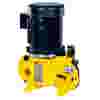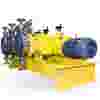What is a reciprocating pump?
A reciprocating pump is a positive displacement pump that captures a moving fluid in a cavity and then discharges a fixed amount of it via mechanical pressure. It is a constant volume pump that operates in low flow and high discharge pressure environments. Milton Roy’s reciprocating pumps can handle flow rates from 0.024 gallons per hour (0.09 liters per hour) to 12,681 gallons per hour (48 cubic per hour) and discharge pressures up to 15,000 psi (1,034 bar).







.jpg?format=pjpeg&width=100&quality=10)
